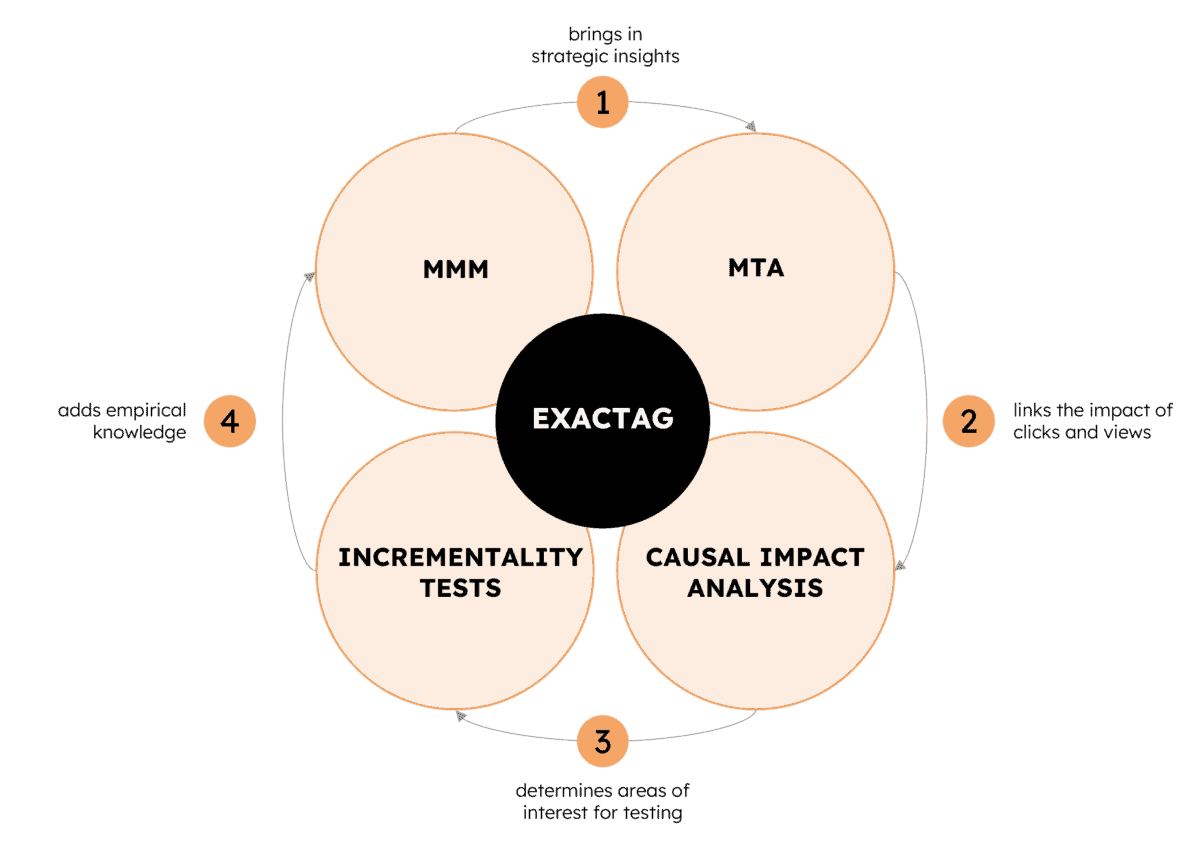TRIANGULATION MASTERY
MMM, MTA, incrementality & causal tools: Discover our advanced approach to triangulation and explore the art and science of combining sophisticated methods for measuring marketing performance.

Embrace innovation, not the buzzwords
In the world of marketing measurement, it’s easy to get caught up in trendy methodologies and buzzwords such as triangulation. But at Exactag, we believe that true innovation lies in how you combine and integrate these tools to drive meaningful results. Many in the industry are familiar with concepts like Marketing Mix Modeling (MMM), Multi-Touch Attribution (MTA), and Incrementality Testing, but few have mastered the art of seamlessly weaving them together.
This article isn’t just another overview about triangulation – it’s an invitation to explore Exactag’s distinctive approach to triangulation. We’ll show you how we integrate these methods, along with Causal Impact Analysis, to create a robust, data-driven framework that transcends conventional wisdom.
With evolving privacy regulations and a fragmented digital landscape, integrating tools like MMM, MTA, Incrementality Testing, and Causal Impact Analysis can future-proof your strategies. Understanding proper integrations shields you from the pitfalls of overhyped solutions, enabling you to make confident, data-driven decisions.
What is triangulation?
Triangulation in marketing measurement refers to the strategic combination of three analytical methods to obtain a more accurate understanding of performance. The term “Triangulation” typically involves integrating methodologies such as: Marketing Mix Modeling (MMM), Multi-Touch Attribution (MTA), Incrementality Testing. Some approaches also incorporate causal analysis techniques instead of another method.
We take triangulation a step further.
At Exactag, we take triangulation a step further by embracing a comprehensive integration that surpasses the traditional trio of triangulation, ensuring that each tool’s strengths are maximized and weaknesses are mitigated.
How we use these methods - beyond triangulation
Let’s explore how we use these methods beyond the traditional triangulation approach and how they work together in our platform to provide you with robust results.
MTA
MTA attributes credit to various marketing touchpoints contributing to a conversion, providing a granular view of how different channels, tactics, formats, etc., influence consumer behavior. It can employ principles like Shapley value, probabilistic models, and information theory to calculate fractional credits.
Role:
MTA provides granular insights for daily optimization of digital campaigns, helping marketers understand the contribution of different touchpoints (ads, channels, formats) to conversions. It also informs tactical decisions on campaign refinement.
Strengths:
- Detailed insights: Provides specific data on how different channels, ads, and tactics contribute to conversions, helping to optimize spend allocation.
- Immediate feedback: Offers daily updates, allowing for quick adjustments to campaigns based on performance.
- Scalable implementation: Can be expanded across various digital campaigns and platforms with automated data processing.
Challenges:
- Digital-only: Primarily effective for digital channels.
- Cross-Device challenges: Requires robust cross-device tracking.
- Data requirements: Relies on sophisticated data collection to overcome non-consent bias.
- Short-term: Focuses primarily on sales within the next weeks.
MMM
MMM evaluates the effectiveness of marketing activities by analyzing time-series data. It assesses the impact of various marketing inputs-such as media spend and external factors-on key performance indicators like sales or brand awareness. Read more about our advanced Marketing Mix Modeling here.
Role:
MMM is used for strategic budget planning and channel allocation, analyzing both the mid-term and long-term impact of various marketing activities across all channels, including both digital and offline.
Strengths:
- Comprehensive overview: Analyzes the impact of all marketing activities, including TV, radio, and digital, over time.
- Long-term impact: Helps identify which channels drive sustained growth and brand equity.
Challenges:
- Time-intensive: Requires extensive data collection and preparation.
- Broad-level insights: Typically provides insights at the channel or medium level, rather than specific campaigns or creatives.
Causal Impact Analysis
Causal Impact Analysis estimates the effect of a specific marketing intervention by simulating what would have happened in its absence, focusing on cause-and-effect relationships.
Role:
Causal Impact Analysis assesses the short- to mid-term effects of marketing activities, particularly useful where direct attribution or experiments aren’t feasible, like brand campaigns or ad impressions.
Strengths
- Cause and effect clarity: Helps determine the actual impact of a marketing action, such as a price promotion or ad campaign, by simulating what would have happened without it.
Challenges
- Data quality dependent: Accuracy depends on the quality and completeness of historical data.
- Less detailed: May not offer the same level of detail as other methods for specific touchpoints or interactions.
Incrementality Testing
Incrementality testing is a method used to determine the additional impact of marketing efforts by isolating the effects of specific interventions. This is typically achieved through controlled experiments, such as A/B testing. This approach helps in identifying which strategies drive growth, as opposed to simply capturing demand that would have occurred anyway.
Role:
Incrementality testing supports strategic decisions by validating new tactics or channels before scaling.
Strengths
- Isolates impact: Clearly shows the additional sales or leads generated by a specific campaign or channel.
- Practical insights: Directly informs where to increase or decrease budget for maximum return.
Challenges
- Controlled environment needed: Requires carefully controlled setups, which can be difficult in dynamic environments.
- Pre-planning required: Must be planned before campaigns are launched, limiting mid-campaign flexibility.
- Test bias: Results can be skewed if not conducted across the entire marketing mix.
- Scalability: Running multiple, concurrent tests without interference can be challenging.
The art of seamlessly weaving them together for maximum impact
Building on the foundations of each measurement method, the real power of marketing analytics lies in how these tools are combined to benefit from each method’s strength. We have assigned the following roles to our methods:

MMM provides a strategic and holistic overview.
MMM offers a broad overview, like a map guiding mid- and long-term marketing decisions. Exactag employs MMM to establish a strategic foundation, offering a high-level view of marketing performance across all channels. By incorporating external factors, macroeconomic data, and market conditions, MMM identifies overarching trends and informs resource allocation. It supports budget and campaign planning, often focusing on sales but also addressing branding.

MTA does the digital deep dive.
Building on MMM’s strategic insights, Exactag uses MTA to precisely dissect digital performance, much like using a compass to measure each touchpoint’s contribution. MTA provides near-real-time, granular analysis of digital touchpoints, enabling quick adjustments to optimize conversions. By integrating MMM’s broad findings with MTA’s detailed data, Exactag ensures that digital strategies are not only reactive but aligned with long-term objectives.

Causal Inference ensures the right alignment of clicks and views.
Exactag applies Causal Impact Analysis to validate the short- and long-term impact of ad impressions, like a protractor fine-tuning the angles of cause and effect. This method is especially useful for assessing the influence of brand, upper-funnel, and non-click-based marketing measures, as it doesn’t rely on granular user-level journey data.

Incrementality tests focus on individual key questions.
Incrementality Testing at Exactag validates the impact of specific marketing measures or tactics, much like magnifying individual actions with the precision of a lens. The results from these tests are fed back into MMM, refining its accuracy and ensuring that strategic decisions are based on solid, empirical evidence.
Continuous refinement: An ongoing cycle of optimization
Exactag‘s modeling process is a continuous loop where each method enhances the next, leading to ongoing optimization and strategic refinement:
1 Exactag has developed a flexible API to integrate MMM results with MTA seamlessly. This integration allows for continuous, automated updates that keep strategic planning and daily optimization closely aligned. MMM is the starting point and informs the MTA about the conversion shares assigned to digital media. MTA then runs the deep dive into digital. MMM input can be ingested on different levels, either for digital in general or for specific channels.

2 By linking MTA’s click-based attribution with Causal Impact’s analysis of ad impressions, Exactag refines attribution models, ensuring a more nuanced understanding of both direct interactions and passive brand exposures. For instance, when search channels receive conversion credit in MTA, Causal Impact helps redistribute that credit to upper-funnel channels that have been proven to influence these conversions through ad impressions.
3 The results from our combined attribution are perfectly suited to identifying key areas for focused experimentation, such as testing new channels or evaluating creative variations. These experiments provide insights to refine MMM priors and enrich your campaign strategies.
4 Given the robustness of well-executed experiment results, we use them to establish the priors for our MMM. Priors are an essential part of MMM, and empirical data are of great value and positively impact the MMM quality.
How to avoid common pitfalls
Exactag’s integration of these methods isn’t just about combining data; it’s about creating a cohesive strategy that drives results. When setting up your toolkit, make sure to pay close attention to common risks in the market:
- Mind data quality: Don’t allow fancy methods to distract your view of the data. Even the best method will not compensate for missing or bad data. This is why no method should be an excuse not to act on the best data available. It’s worth following a best-of-breed approach in data collection and modeling. Prioritize robust data collection and validation processes to ensure that even the most sophisticated methods yield accurate results.
- Scrutinize publisher-driven tests: While publisher-led tests can be informative, they often lack the objectivity and comprehensive scope needed for accurate insights. Exactag prioritizes neutral, integrated measurements that provide a balanced view of your entire marketing ecosystem.
- Focus on integrated results: Exactag emphasizes the importance of fully integrating data and insights. This holistic approach prevents inconsistencies and the trouble fo using multiple tools or reports. It enables your team to make consistent, data-driven decisions across all channels.
- Managing model quality: The output of one model may serve as an input for another, creating interdependencies that need careful management to avoid double consideration of factors. Ensure that each model is independently validated before integration. Updating validated results with unvalidated inputs can lead to inconsistencies and distortions, undermining the integrity of your analysis.
Book a free virtual meeting with our experts.
Do you want to take triangulation a step further? Get to know our distinctive approach to triangulation and understand how you can benefit from all the features you need in just one platform.